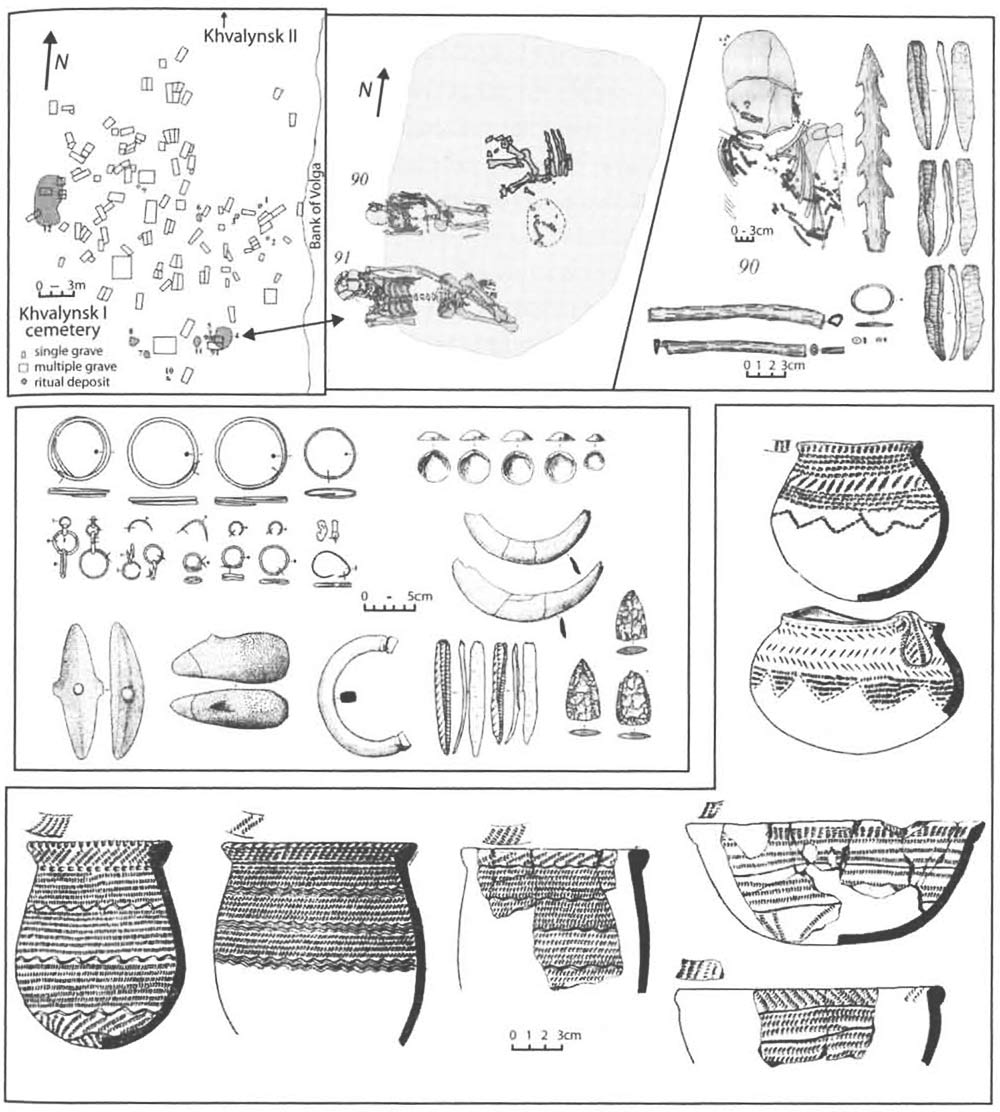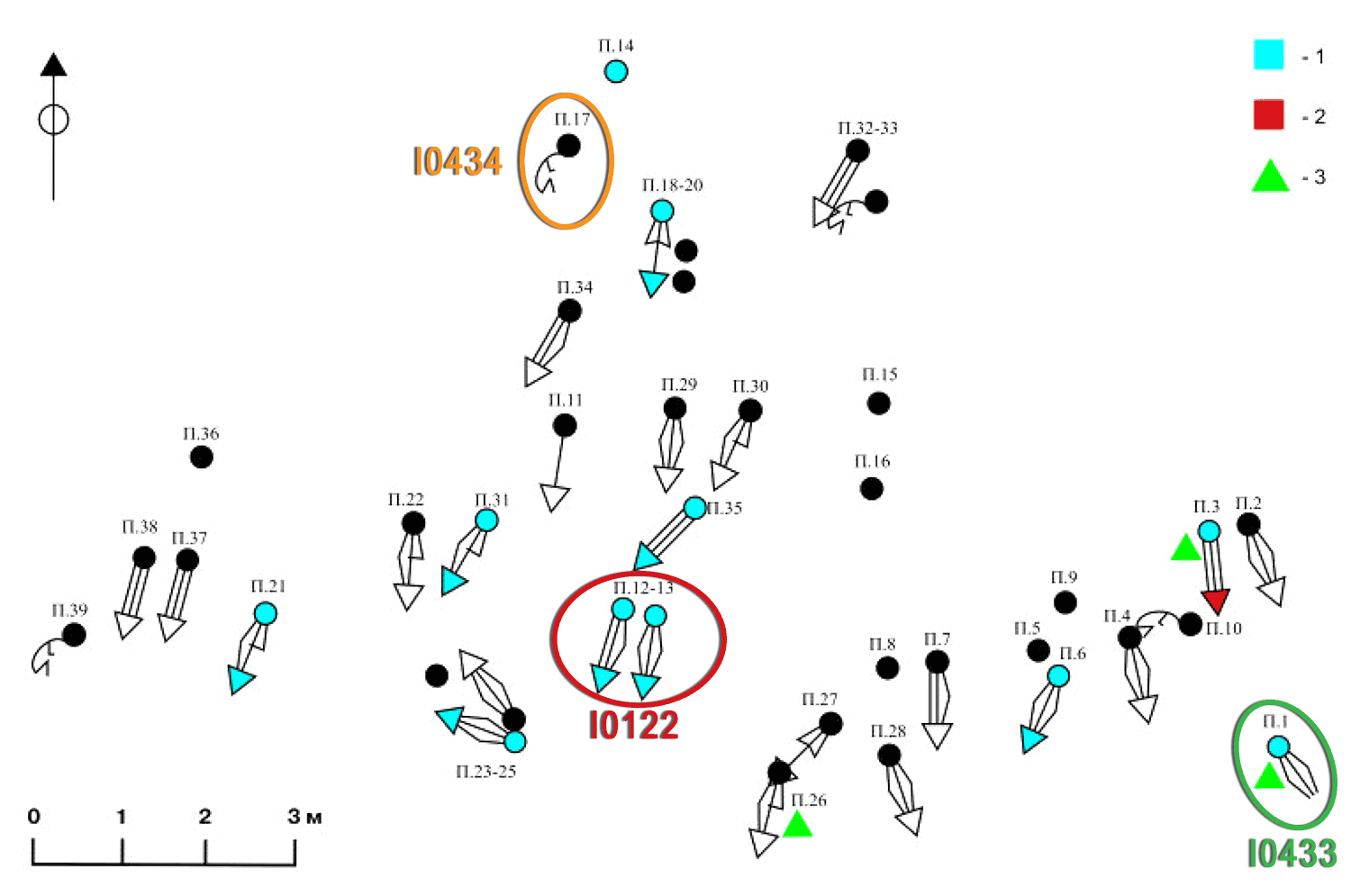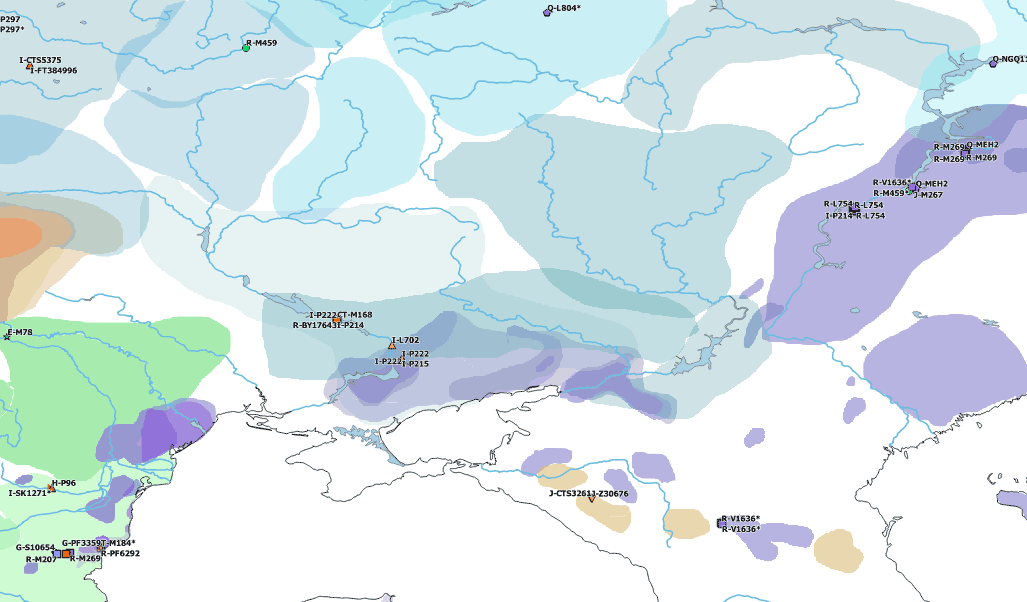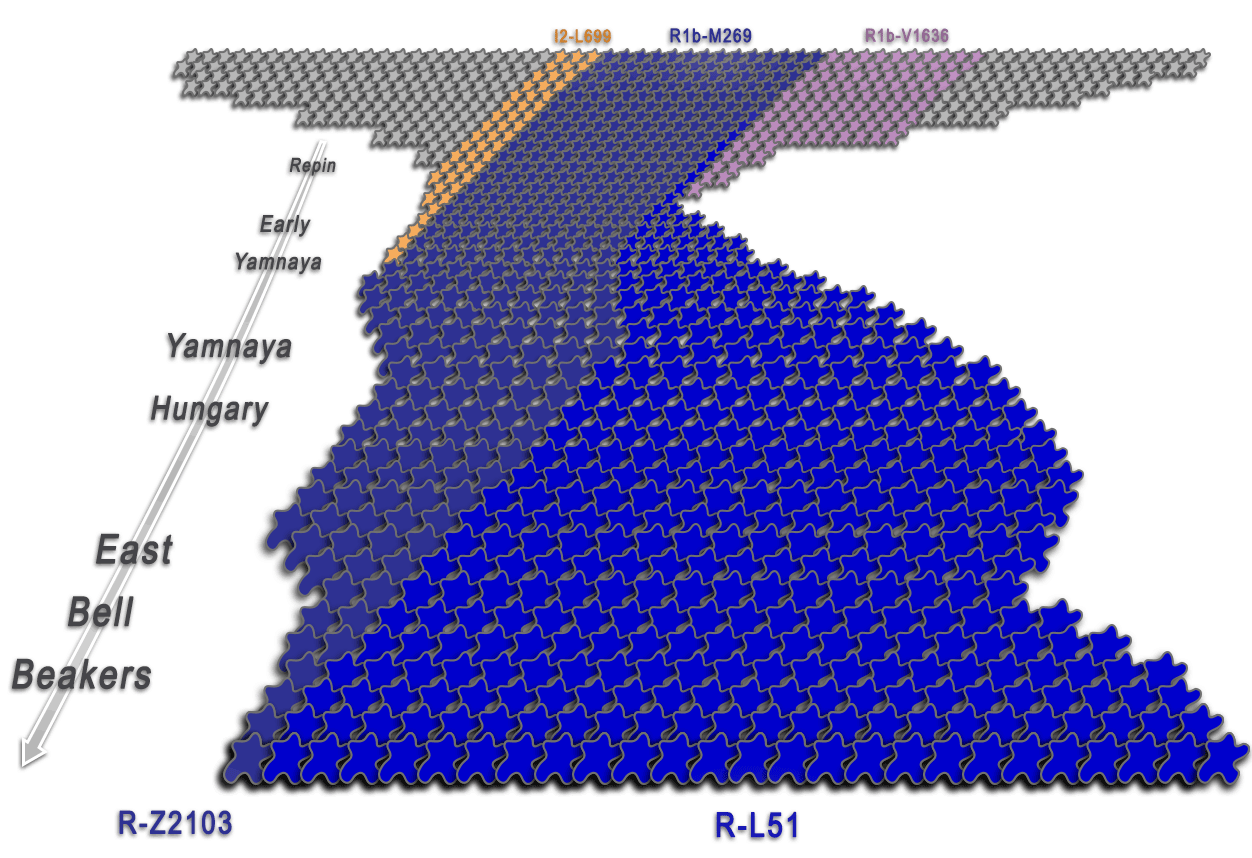I have been updating the Ancient DNA Dataset with date estimates published in the recent preprint by Sedig, Olalde, Patterson & Reich bioRxiv (2020), and it had a reference to some interesting new samples from Khvalynsk, showing tight family connections.
Information below is taken from the preprint and from the latest version of the Reich Lab’s Allen Ancient DNA Resource (AADR). Information about the three published Khvalynsk samples is taken from Mathieson et al. Nature (2015) supplementary materials, and each ID features a different font color in the text below for clarity’s sake.
Khvalynsk Family A
I0434, Y-DNA Q>MEH2(xF1096>M25, xM346), mtDNA U4a2 or U4d, Khvalynsk II Grave 17, SVP HB 47 Q (ca. 5198-4853 calBCE). Age 45-55, positioned contracted on his side, with 4 pathological wounds on his skull, one of which probably was fatal. No grave gifts or animal sacrifices accompanied the burial.
I0433, Y-DNA R1a>M459(*?; xM198, xYP1301>YP1272, xYP1301>FT386000), mtDNA U5a1i, Khvalynsk II Grave 1, SVP HB 46 (ca. 4697-4539 calBCE). Age 30-35, positioned on his back with raised knees, with a copper ring and a copper bead. His R1a1 haplotype shows that this haplotype was present in the region, although it is not represented later in high-status Yamnaya graves.
* The sample has 8 derived, 1 ancestral (Y214, 1x T->A) Y-SNP calls for M459, and no calls for YP1301, so it could be pre-M459, M459*, or within the YP1301* branch.
Khvalynsk II Family A (5 members, 3 of them unpublished):
- I0434–I6740 are 2nd degree relatives.
- I0434–I6407, I0434–I6734, I0433–I6740 are 3rd degree relative pairs.
- I6407–I6734 are siblings.
Both known Khvalynsk samples are, therefore, distantly related (both through a 3rd degree connection with unpublished individual I6740), and it makes sense that hg. Q1 will appear in other Khvalynsk samples, but also among the Yamnaya from the Carpathian Basin. As for the difference in burial custom, ancestry, and (potentially) of dates, it is yet unclear what their relationship to chronological changes might be, but the radiocarbon dates of their kin might help further delimit the currently visible difference (mean ca. 5000 BC vs. ca 4600 BC).

From Anthony (2007):
Khvalynsk was by far the largest excavated Khvalynsk-type cemetery; most others had fewer than 10 graves. At Khvalynsk most of the deceased were layered in group pits, somewhat like DDII graves, but the groups were much smaller, containing only two to six individuals (perhaps families) buried on top of one another. One-third of the graves were single graves, a move away from the communal DDII custom. Only mature males, aged thirty to fifty, were exposed and disarticulated prior to burial, probably an expression of enhanced male status, associated with the introduction of herding economies elsewhere in the world. Few children were buried in the cemetery (13 of 158), but those who were included some of the most profusely ornamented individuals, again possibly indicating that status was inherited. The standard burial posture was on the back with the knees raised, a distinctive pose. Most had their heads to the north and east, a consistent orientation that was absent in DDII cemeteries. Both the peculiar posture and the standard orientation later became widespread in steppe funeral customs.

Khvalynsk Family H₃rḗgs
I0122, Y-DNA R1b-pre-V1636, mtDNA H2a1, Khvalynsk II Grave 12, SVP 35 (ca. 4936-4730 calBCE). Age 20-30, positioned on his back with raised knees, with 293 copper artifacts, mostly beads, amounting to 80% of the copper objects in the combined cemeteries of Khvalynsk I and II. Probably a high-status individual, his Y-chromosome haplotype, R1b1, also characterized the high-status individuals buried under kurgans in later Yamnaya graves in this region, so he could be regarded as a founder of an elite group of patrilineally related families.
NOTE. For an explanation of why it is R1b-pre-V1636, and how it relates to other samples, see Recent Yamnaya-related intrusion in a Denmark Late Neolithic burial, and The Last of the Single Gravers.

Khvalynsk – Khlopkov Bugor cross-site family with 8 members, 7 from Khvalynsk II (6 unpublished) and 1 unpublished from Khlopkov Bugor:
- I6301–I6107 have a 2nd or 3rd degree relation across sites;
- I0122–I6403–I6406 have an uncle-father-son relationship;
- the sibling pair I0122–I6403 are also:
- 2nd degree relatives of I6736 (who is thus a 3rd degree relative of I6406),
- and 3rd degree relatives of I6738, I6109, and I6107;
- finally I6107–I6109 are 3rd degree relatives.
Two of these samples have already known dates:
- Brother I6403 Russia_Khvalynsk_Eneolithic, Khvalynsk II, petrous 6820, 4941-4798 calBCE (5985±25 BP, PSUAMS-4200).
- Nephew I6406 Russia_Khvalynsk_Eneolithic, Khvalynsk II, petrous 6775, 4908-4742 calBCE (5950±25 BP, PSUAMS-4153).
Together with the Khvalynsk h₃rḗgs I0122, all three point to ca. 4934-4777 BC as their most likely time span.
A Y-DNA bottleneck under R1b-pre-V1636 lineages among Early Proto-Indo-Europeans could already be inferred from Khvalynsk samples from the Northern Caucasus Piedmont, as a sign of expanding Proto-Indo-Anatolians; and from a much younger sample from Arslantepe, as a sign of the Proto-Anatolian-speaking community that spread with Suvorovo migrants or their descendants into Anatolia.

This elite family dominance marked by hg. R1b-pre-V1636 ended apparently with the dissolution of the Khvalynsk community at the end of the 5th millennium BC, and the emergence of the succeeding Repin pastoralist society in the Don-Volga region.
This crisis and shift of the center of power are probably the main reason for the linguistic changes that led to the development of a unitary Proto-Indo-Tocharian, and also of the marked Y-DNA bottleneck under R1b-L23 subclades with a very specific type of ancestry, as evidenced by Pre-Tocharian-speaking Afanasievo and Core-Indo-European-speaking Yamnaya. We already know that M269 formed part of Khvalynsk, so the formation date and TMRCA of L23 at the end of the 5th millennium makes perfect sense:
- The Smyadovo outlier of Steppe ancestry and hg. R1b-M269(xZ2103) is expected to be basal M269* due to its date, spreading among Suvorovo migrants into Anatolia together with R1b-pre-V1636.
- Of the more than 30 Khvalynsk samples of hg. R1b expected to be published from Khlopkov Bugor, Khvalynsk, and Ekaterinovka, we already have a previous report (unofficially confirmed) of R1b-M269 samples from Ekaterinovka in the late 5th millennium BC, which I guess now are more likely to be R1b-L23.
- Apparently, the Copenhagen lab also has some R1b-M269* and R1b-L51 from Yamnaya, on top of the already published or leaked R1b-L51 from Afanasievo, Yamnaya Bulgaria, and Yamnaya from the Carpathian Basin, which closes the circle of an evidently tight kinship structure among Proto-Indo-Europeans.
I believe this is the oldest R-M269 currently known! Based on its coverage it could be ancestral for the two children nodes of R-M269, but no coverage.
— Iosif Lazaridis (@iosif_lazaridis) January 23, 2021
For more on this question, see Proto-Indo-European kinship system and patrilineality.

See also
- Proto-Indo-European kinship system and patrilineality
- Volga Basin R1b-rich Proto-Indo-Europeans of (Pre-)Yamnaya ancestry
- Demographically complex Near East hints at Anatolian and Indo-Aryan arrival
- Proto-Anatolians: from the Southern Caucasus or the Balkans?
- Origin of DOM2 closing in on the Pontic-Caspian steppes
- Proto-Uralic Homeland (VII): Kinship & Numerals
- Fully Steppe-like Proto-Corded Ware Late Trypillians
- “Steppe ancestry” step by step (2019): Mesolithic to Early Bronze Age Eurasia
- Trypillia and Greece Neolithic outliers: the smoking gun of Proto-Anatolian migrations?